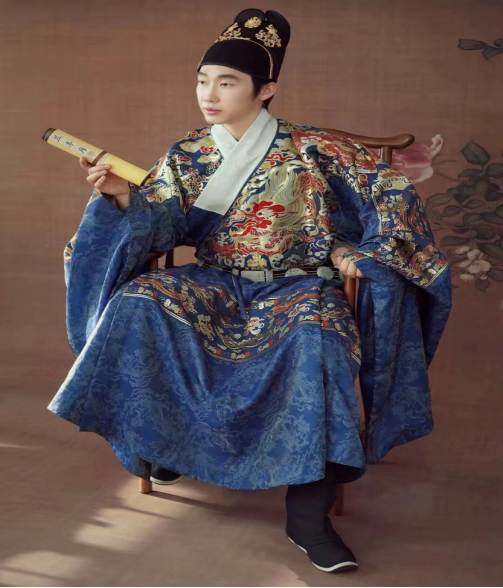What are the stages of the development of Hanfu?
The development of Hanfu can be divided into three stages: origin, formation, and evolution. This journey spans thousands of years, In different stages, they carry specific cultural connotations,has its unique characteristics. Nowadays, with cultural exchanges, Hanfu has once again entered people’s daily lives due to its beautiful lines, exquisite embroidery, and accessories, becoming a hot topic in the global fashion field. So how does Hanfu showcase its charm and attract so many people’s attention and affection?

Hanfu Origin Stage
The origin of Hanfu is closely related to textile technology. Before the advent of textile technology, people’s clothing was made from leaves and animal skins. During the Xia, Shang, and Zhou dynasties, hemp and silk began to be used for making clothes, giving rise to the basic form of the upper and lower garments. The upper garment was generally an overlapping neckline on the right side, short in length, while the lower garment was a skirt worn around the waist. The Zhou Dynasty also established a dress code, specifying the requirements for different ranks, positions, and occasions, becoming a model for ancient Chinese dress codes.

Hanfu Formation Stage
During this period, various systems including those forclothing and headwear were established, and the dress code was gradually perfected. Norms regarding styles, colors, and decorations of clothing were established and passed down. The dress system established during the Qin and Han dynasties laid the foundation for Hanfu, which later gave rise to the term “Hanfu”.

Hanfu Evolution Stage
Hanfu reached its peak during the Tang, Song, and Ming dynasties. Whether in terms of style, fabric, craftsmanship, or accessories, it reached new heights. Tang-style high-waisted skirts and tunics with open and elegant elements were well-known. Song-style vests and swirling skirts focused more on details and elegance, becoming fashion icons. Ming-style Hanfu reached new heights in design, fabric selection, and production techniques, becoming the quintessence of Hanfu’s development.
Classic Hanfu Styles

Tang-style high-waisted skirts paired with large-sleeved tops, with skirts flowing like streamers and modestly low necklines. The fabrics used were brocade and chiffon, light and breathable, suitable for spring and summer outings or Hanfu weddings.

Song-style vests + swirling skirts featured straight necklines and front-opening vests paired with one-piece swirling skirts. With sharp and simple cuts, narrow sleeves, and a waist-cinching design, they highlighted the refined elegance of scholars. Fabrics like cotton and linen, as well as gauze, were chosen for their comfortable feel, making them suitable for everyday wear.

Ming-style Hanfu, paired with collared long coats or round-collared robes, featured mamianqun that were stiff and shaped, with intricate gold weaving, embroidered patterns, or floral designs at the skirt openings, exuding a sense of solemnity and grandeur. Fabrics such as gold brocade and embroidered gauze were used, making them suitable for important celebrations and traditional festivals.
Nowadays, you can see Hanfu all over the world. Videos about Hanfu on the internet continuously gain high view counts, and overseas students wearing Hanfu to graduation ceremonies have astonished many. The main reason is that modern Hanfu retains core elements of traditional Hanfu, such as the overlapping neckline and tie strings, blending the past with the present. For example, modern dresses incorporate the high-waist design of Tang-style skirts with contemporary silhouettes, adding pleats or prints of mamianqun to the hem; Hanfu jackets modify Ming-style bijia and Song-style front-opening short tops into short cardigans, simplifying some of the overly complex structures and decorations of traditional Hanfu, making them more concise and stylish.







